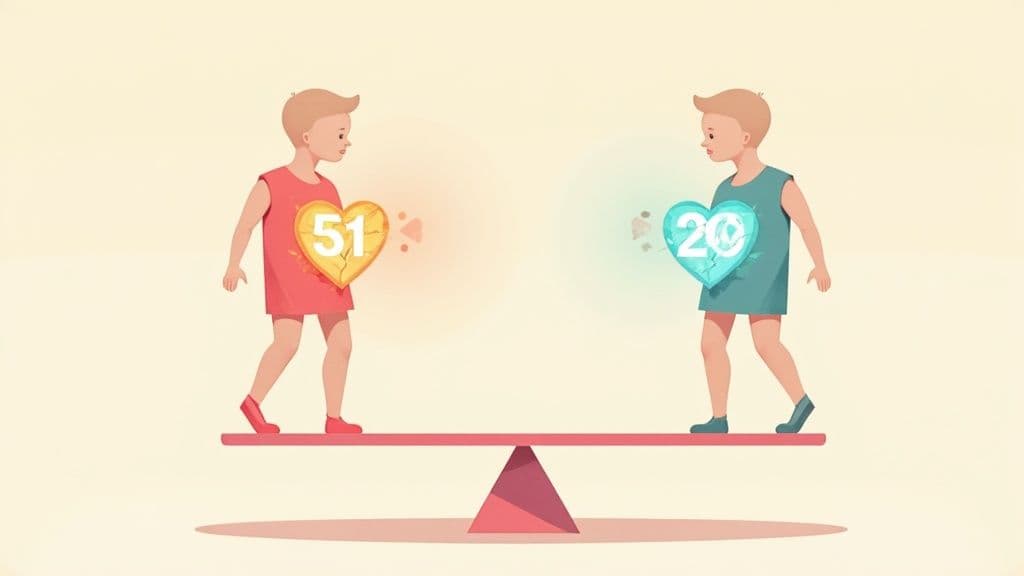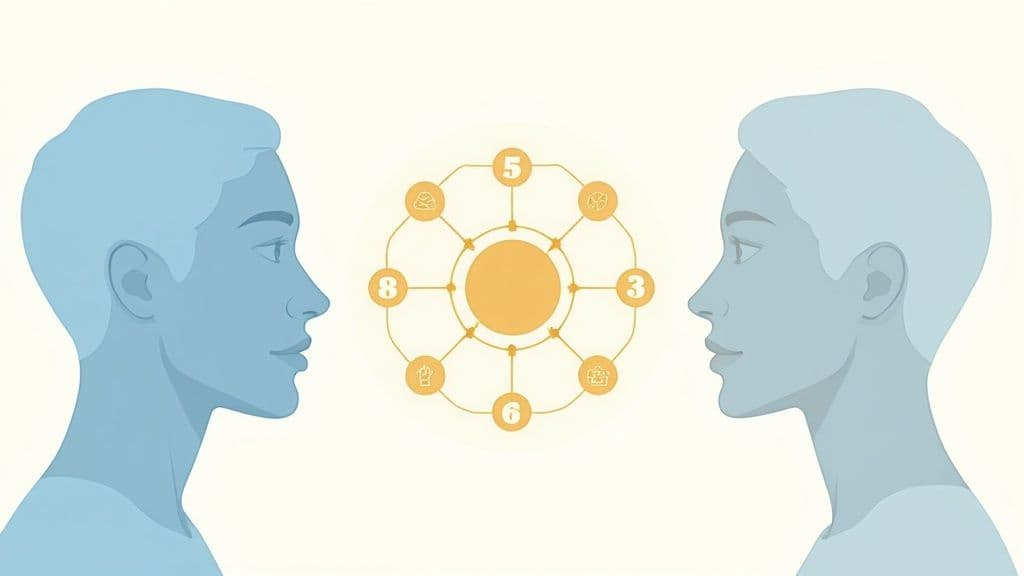Discover your unique relationship strengths and weaknesses using a fresh perspective. Learn to build a stronger, more authentic bond with practical insights.
November 10, 2025 (4d ago)
Uncover Your Relationship Strengths and Weaknesses
Discover your unique relationship strengths and weaknesses using a fresh perspective. Learn to build a stronger, more authentic bond with practical insights.
← Back to blog
Assess Your Relationship Strengths & Weaknesses
Summary: Discover your relationship’s strengths and weaknesses through life-path insights and practical steps to build deeper connection and resilience.
Introduction
If you want a partnership that can weather any storm, start by honestly naming your relationship strengths and weaknesses. A great relationship isn’t one without disagreements — it’s one where both partners understand the unique dynamics that make them click, from shared humor to how they handle crisis. This article gives a clear, practical framework to help you spot where you shine together and where a little extra attention will make a big difference.
What Defines a Truly Strong Relationship

Real, lasting love is built on small, consistent efforts and a genuine understanding of one another. A strong bond is flexible, resilient, and honest — able to bend under pressure without snapping. Like a seasoned oak, its strength comes from deep roots (your character) and branches that sway in the wind (your ability to adapt together). That foundation depends on a few core elements every couple needs to nurture.
The Pillars of a Lasting Connection
- Open communication: More than talking — it’s creating a space where both feel safe to be vulnerable and honest.
- Mutual trust and respect: Trust is the ground a healthy relationship stands on; respect honors each partner’s perspective and needs.
- Shared values and goals: You don’t need to be identical, but aligned core values give you a compass for the future.
Life’s pressures will test these pillars. Research and relationship surveys show common friction points and practical ways couples improve satisfaction through simple habits like regular check-ins2 and clear financial planning3.
Ultimately, knowing your relationship priorities helps you focus energy where it matters most and make intentional choices about what you want to build and protect4.
A New Lens for Your Relationship Blueprint

Imagine a map that reveals the hidden patterns and currents in your relationship — a clear language for why you click in some areas and clash in others. That practical framework comes from Dan Millman’s system in The Life You Were Born to Live, which is also implemented in tools like the Life Purpose App17.
Your Life Paths as a Guide
Life paths are derived from birth dates and point to natural talents, learning edges, and the lessons each person is likely exploring in life. When partners combine their life paths, they form a shared energetic signature that helps explain recurring patterns — not to judge, but to illuminate.1
Seeing these core energies laid out is often an “aha” moment: recurring arguments become understandable, and differences feel less like personal attacks and more like expressions of distinct life-path energies. Combining life-path insights with attachment theory offers a fuller picture of your dynamic and how to discuss it with curiosity and compassion5.
Use numerology insights to surface patterns and practical ways to strengthen connection and mutual understanding8.
Uncovering the Core Strengths in Your Connection
Every relationship has a special blend of energy and talent. Looking through the life-path lens helps you name those strengths and appreciate what each partner naturally brings to the table. These strengths aren’t small quirks — they’re core qualities that shape how you support and lift each other.
What Shared Gifts Look Like in Real Life
Here are a few concrete examples of how life-path energies can show up in everyday partnership:
- A Life Path 2 brings cooperation and harmony — the natural peacekeeper who diffuses tension.
- A Life Path 5 brings freedom and adventure — the partner who keeps life fresh and encourages growth.
Recognizing these roles helps you celebrate contributions rather than take them for granted. Global surveys show many people feel loved, yet relationship satisfaction can lag — often because partners don’t consistently recognize and use each other’s strengths5.
Other Life Path Strengths
- Life Path 3 — Creative Communicator: Expression, joy, and emotional honesty that prevent misunderstandings.
- Life Path 4 — Steady Builder: Stability and loyalty that create security and trust.
If you want to sharpen the skills that keep conversation flowing, resources on improving conversation habits are a practical next step10.
Common Life Path Strengths in Relationships
| Life Path Number | Core Gift | How It Strengthens a Relationship |
|---|---|---|
| 1 | Creativity & Confidence | Inspires independence and encourages both to pursue goals. |
| 2 | Cooperation & Balance | Creates a harmonious, supportive space where both feel heard. |
| 3 | Expression & Sensitivity | Fosters open communication and emotional honesty. |
| 4 | Stability & Process | Builds a secure, dependable foundation of trust and loyalty. |
| 5 | Freedom & Discipline | Infuses the relationship with adventure and growth. |
| 6 | Vision & Acceptance | Nurtures a loving home and highlights the best in each other. |
| 7 | Trust & Openness | Encourages deep intellectual and spiritual connection. |
| 8 | Abundance & Power | Drives shared success and empowers each partner’s potential. |
| 9 | Integrity & Wisdom | Brings higher purpose, compassion, and unconditional love. |
Navigating Inherent Relationship Challenges
Every life path brings gifts and shadow tendencies. The point isn’t blame — it’s awareness. For example, a joyful Life Path 3 may also face self-doubt, while a dependable Life Path 4 may sometimes become rigid. Recognizing these shadow sides reframes conflict as a prompt for growth and mutual support.
When strengths are overused, they can tip into weaknesses. The confident leader (a ‘1’) can feel dominant; the cooperative partner (a ‘2’) can avoid necessary conflict. Seeing these patterns helps you respond with curiosity rather than blame.
Acknowledging shadow aspects lets you treat difficult moments as opportunities for deeper empathy and connection.
Turning Weaknesses Into Growth Opportunities
Simple, proactive steps help convert friction into connection:
- If a partner with a Life Path 6 tends to worry, offer reassurance rather than frustration.
- If you notice your own Life Path 5 restlessness, communicate your need for space before it escalates.
This conscious approach requires teamwork and compassion. The life-path framework offers a shared language for growth, helping you honor both light and shadow in one another1.
How to Use These Insights in Your Relationship
This framework is most useful when it becomes a conversation starter — not a label or a weapon. Start by finding your life-path numbers (the Life Purpose App calculates them instantly), then approach the results with curiosity and humility7.
Kicking Off the Conversation
Try gentle prompts that invite dialogue rather than defensiveness:
- “I tried this app and it said your biggest gift is [mention strength]. I see that when you [specific example]. Does that ring true?”
- “It suggested one of my challenges is [mention weakness], and I noticed that when I [example]. Have you noticed that in me?”
- “What do you think about the idea that we, as a couple, have our own set of gifts and hurdles?”
From Insight to Teamwork
Make these conversations ongoing. Use insights as a shared toolkit — not a one-off diagnosis. When you treat your partner’s challenge as something you can support rather than fix, you move from “you vs. me” to a stronger “us.” For example, if rigidity shows up for a ‘4’, invite flexibility with curiosity; if impatience shows up for you, ask your partner for help practicing calm.
Frequently Asked Questions
Q: How do I find my life path number?
A: The easiest way is to use the Life Purpose App, which calculates life-path numbers from full birth dates and explains what each number means in practical terms7.
Q: What if our life paths seem to conflict?
A: No pairing is doomed. Every combination creates a distinctive energy with its own gifts and challenges. Awareness of those differences lets you anticipate friction and respond with compassion instead of escalation1.
Q: Is this the only framework I should use?
A: No. This is a helpful tool among many. Open communication, regular quality time, and counseling remain central. Life-path insight complements these practices by giving you a specific language for dynamics that are often hard to name5.
Ready to uncover your shared blueprint? The Life Purpose App gives instant access to life-path insights based on Dan Millman’s work, helping you understand strengths, navigate challenges, and build a deeper connection7.
Discover Your Life Purpose Today!
Unlock your true potential and find your life’s purpose.
